Partnering in Patents Developments
This week, over a thousand attendees are expected at the annual meeting of the American Intellectual Property Law Association (AILPA). Several Vorys attorneys are participating as leaders and attendees.
Today in a pre-meeting briefing, senior U.S. Patent and Trademark (USPTO) officials gave updates on key areas of ongoing activity by the Office. This activity essentially relates to improving inclusion in the patent system and harnessing artificial intelligence (AI) and automation in patent examination.
Here are highlights most relevant to companies, inventors, and stakeholders.
Highlights
Inclusion
Led by Tricia Bianco, Senior Advisor to Deputy Commissioner of Patents
As announced today, Secretary of Commerce, Gina Raimondo, will chair a re-branded Council for Inclusive Innovation (CI2). The Council works with the USPTO, industry, academics and other stakeholders to set national policy on expanding the nation’s diversity in the innovation ecosystem. The Council aims to increase participation in the patent system by women, minorities, veterans, and people from geographical areas or with incomes that are underrepresented now.
This work builds on an earlier USPTO report from 2019, updated in 2020, finding women to be underrepresented as patent inventors. Key findings include:
- the percentage of patent inventors who were women was about 12-13% from 2016-2018;
- the number of patents with at least one female inventor increased from 7% in the 1980s to 21% in 2016, and almost 22% in 2019;
- women are increasingly likely to patent on large, gender-mixed inventor teams; and
- percent of women in new inventor-patentees rose from about 5% in 1980 to 17.3% in 2019 shown in Figure below.

The Council and its working group helped issue a request for comments in the Federal Register earlier this year and are working on a report and recommendations to expand inclusion. More work is underway to provide information to demystify the patent system, mentor innovators, and foster community groups.
AI and Automated Patent Examination
Led by Jay Kramer, Director, Technology Center 2400, Nelson Yang, Senior Advisor for International Business Solutions, Michael Their, Supervisory Patent Examiner, Technology Center 2400, and Richard Fernandez, IT Project Manager, Office of Patent Information Management.
Automation and artificial intelligence is being used to enhance different aspects of the patent examination process. Several tools are already in use, in prototype or close to roll out.
Classification
The USPTO and part of its partnership with the European Patent Office (EPO) continues to expand its use of a multi-symbol CPC classification system.
New aspects of CPC in classification of US cases include:
- Multiple symbols (not just one) are used to classify an application
- Symbols are directed to an entire disclosure not just a comprehensive claim as in the past
- Applications are assigned to an examiner by matching an application’s multi-symbol classification picture with an examiner’s profile.
- The examiner’s profile used to match includes a multi-symbol representation of an examiner’s work experience on final and non-final office actions, allowances, ex parte Quayle actions, first action interview pilots, and examiner’s answers in appeals.
- Other factors used to assign a case to an examiner are the size of the examiner’s new application docket and number of applications in unsigned backlog for which examiner has symbol qualification.
Search
- USPTO has an AI search tool in prototype development.
- Tool aims to enhance search effectiveness early in process.
- Goal is to release AI search capabilities to examiners.
Interviews
- Automated Interview Request (AIR) form allows practitioners to electronically request and schedule an interview with an Examiner.
- In use since 2015, AIR is now handling about 3000 requests/month.
Filing
The roll out of Patent Center portal to replace legacy PAIR and EFS-Web filing systems continues.
- Patent Center can receive DOCX documents.
- Patent Center automatically scrubs DOCX documents to remove certain metadata.
- Patent Center also scans and gives warnings and errors prior to submission.
- Pre-submission feedback may include abstract word count, improper claim dependency, duplicate or missing claim numbers, and specification paragraph numbering detection.
- Multi-part documents are automatically split by Patent Center.
- Filing in DOCX eliminates the notorious non-embedded font error!

